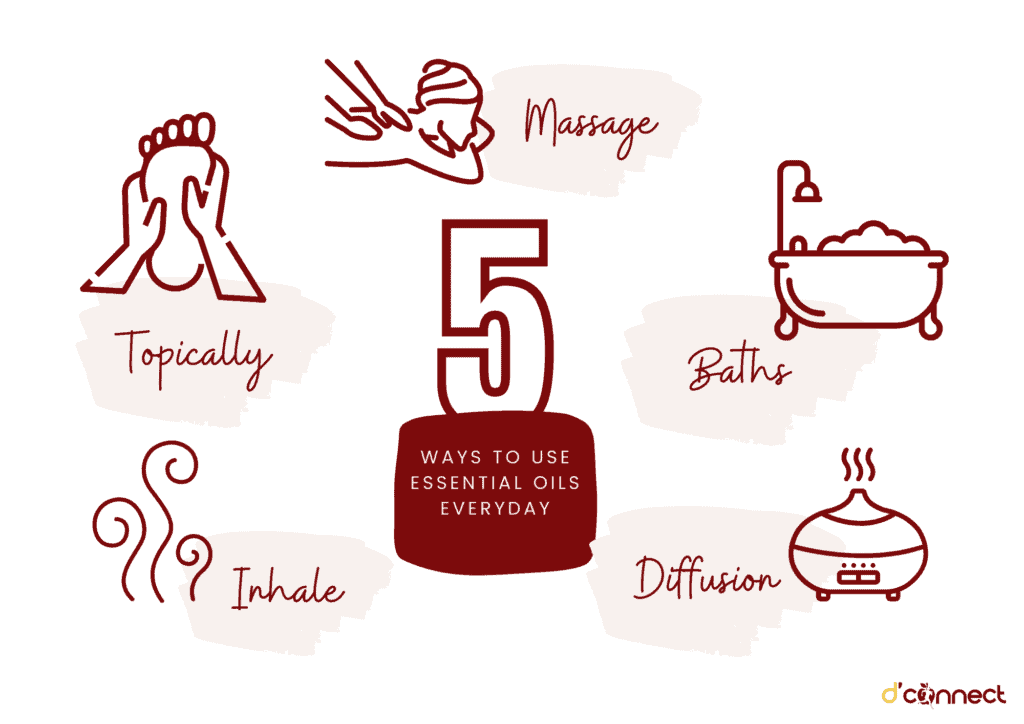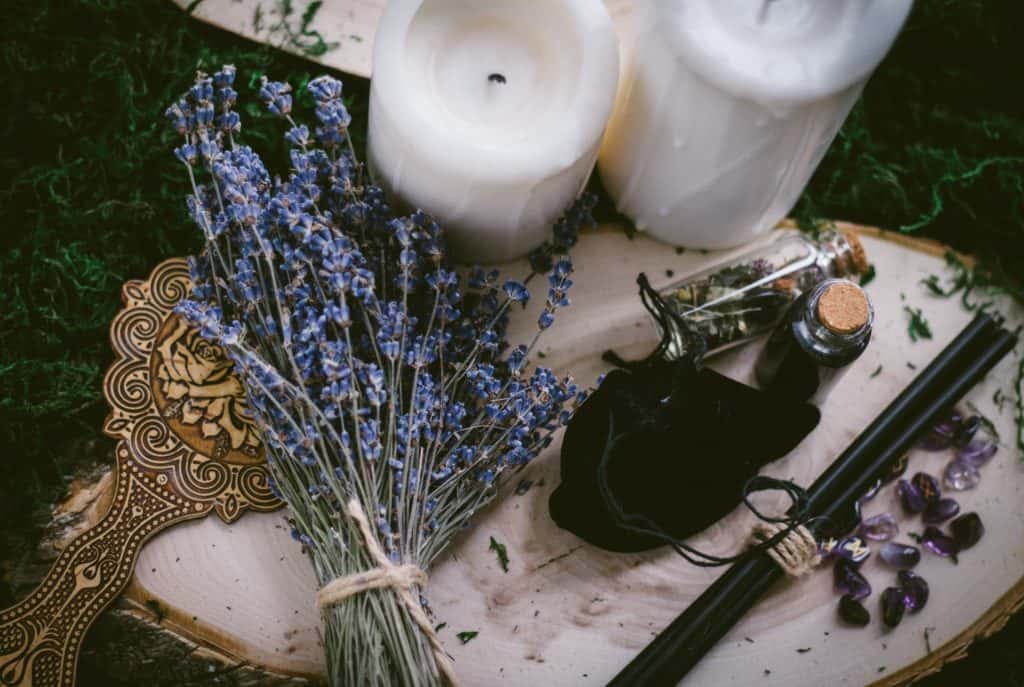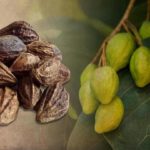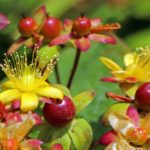
Angelika Klotz
(Holistic therapist)
Note — The article was checked and updated October 2023.
Essential oil therapy or aromatherapy is a holistic approach to healing the mind and the body. Today, aromatherapy is gaining more recognition due to much research done on the benefits of essential oils, natural plant extracts and aromatic plant compounds.
But with over a hundred different essential oils, how do we know which one to select and when to use exactly – morning, afternoon or evening?
Before we answer those questions, let us first start from the beginning and understand the origins of essential oils.
What is aromatherapy
Aromatherapy is a branch of phytotherapy or botanical medicine that uses only natural plant products. Because of their natural heritage and human connection to nature, the healing symbiosis of essential oils is astonishing.
Aromatherapy utilises highly concentrated, volatile essential plant essences and their specific healing capabilities in order to achieve a truly holistic balance of physical health, emotional wellbeing, mental strength and spiritual connection.
Aromatherapy is not an invention of modern times, it has been used since the dawn of humanity. In ancient Egypt, oils like aniseed, cedar, onion, myrrh and grapes were used in perfume and body ointments – as we learn from queen Cleopatra.[1]

During the mummification process fragrances were added to the bodies before they were laid into their tombs. Jesus received gifts of frankincense and myrrh at his birth, Romans used plant essences for healing purposes and Persians used oils in their cooking for their antibacterial and antifungal properties.[2]
The Persians are also known to have invented the first distillation process. Distillation made plant essences more potent and most essential oils are still extracted this way.
Science behind aromatherapy - what does research say
In the 15th century Paracelcius was the first European who studied widely used oils in depth, such as rosemary, rose, sage, juniper.[3]
During the big plague in the 17th century, doctors protected themselves with a face mask and were breathing through a beak containing cinnamon, clove and aromatic herbs.
It was the French chemist and perfumer Rene-Maurice Gattfosse who started the therapeutic use of essential fragrances after a laboratory accident. He had submerged his hand into lavender oil after burning it. The wound healed quickly and did not leave a scar. His 1939 published book “Aromatherapy” started the modern trend of aromatherapy.[4]
Many scientists have helped to explain the chemical backbone of aromatherapy as most essential oils contain over a hundred chemical constituents, amongst them two very prominent groups.
Hydrocarbons
- monoterpenes that are stimulating and have antiviral properties
- sesquiterpenes that have anti-inflammatory and anti-allergic properties.
Oxygenated compounds
- esters that are active on the central nervous system
- alcohols that are energising, antibacterial and antiviral
- aldehydes that are sedative and anti-inflammatory
- ketones that are cell-regenerative
- phenols that are stimulant and antibacterial.[5]
Are Essential Oils natural
Essential oils are naturally derived from plant matter such as flowers, leaves, branches, shrubs, grasses, fruits, seeds, roots, bark, resin and trees.
How are essential oils made
Most essential oils are extracted from plant matter through the distillation process, converting the volatile liquid into vapour to be condensed into floral water (hydrosols) and essential oils after cooling.

Delicate flowers such a jasmine or tuberose would release their fragrance into a highly purified and odourless, solid fat – a process that is called enfleurage. This highly costly process is not used widely anymore.
Most citrus fruit oils are expressed from the peel. Cold expression is preferred as it leaves the essential oils unchanged.
Raw materials with very low concentrations of essential oils or that contain lots of resin are better extracted by a solvent, either liquid (hexane, methanol, ethanol) or gas (butane, carbon dioxide).
The solvent mixture is being distilled which creates a concentrated extract called the concrete. The concrete is warmed with alcohol to melt it, afterwards filtered which leaves an essential absolute, a particular essential oil that contains the highest concentration of natural fragrance possible.
Essential absolute extraction contains the highest concentration of natural fragrance
Absolutes are favourites for their fragrance, however, therapeutic use can be debated because of residues of the solvent.
Difference between essential and fragrance oils
Fragrant oils are usually not natural. They are synthetic produced fragrances that are petroleum based without any therapeutic value.
The perfume industry especially relies heavily on such components because it makes the process standardised. Most essential oils are produced for food flavouring or industrial application.
Only 5% of the yearly essential oils productions are oils that are suitable for aromatherapy because of their therapeutic constituents.
True natural essential oils are like wine, they reflect the spirit of that year’s season and the quality of oils can vary depending on the year’s yield.
Aromatherapy Benefits
Essential oils support better sleep
Having a good night’s rest supports the repair mechanism of the body and the regeneration of the brain. Both are important to stay physically healthy and strong, and mentally agile and resilient. Essential oils that support healthy sleep are lavender, roman chamomile, mandarin, and vetiver.[6]
Essential oils reduce stress and anxiety
Because of the direct pathway of the sense of smell to the oldest part of the brain, the limbic system, smelling relaxing oils bypass the thalamus, the conditioned filter of the brain. The parasympathetic nervous system response kicks in quickly and brings forward immediate relaxation.
RELATED — Understanding Stress: The Silent Killer
Essential oils that support relaxation and anxiety release are frankincense, neroli, petitgrain, rose, and valerian.[7]
RELATED — Increase in Anxiety: Are we “The Anxious Generation”
Essential oils boost our cognitive performance
The direct pathway to the limbic system of the brain also supports performance enhancing actions of oils such as noradrenaline stimulation. Direct actions of oils such as peppermint and rosemary on the amygdala and hippocampus support mental stimulation.[8]
Essential oils heal fungal, bacterial and viral infections
Many essential oils have highly effective chemical compounds that help to overcome fungal infections like athletes foot (manuka, tea tree, German chamomile), bacterial infections like sore throat (eucalyptus, manuka, palmerosa, ravensara) and viral infections like herpes (geranium, melissa, lavender, tea tree).
In fact, many studies show that the antibacterial properties of essential oils are much higher than any antibiotic.[9]
Essential oils contain antioxidants
The anti-oxidative effects of essential oils prevent cell damage from free radicals (clove, frankincense, rose, helichrysum). This keeps us healthier and younger for longer.[10]
Essential oils reduce pain
The analgesic and anti-inflammatory effects of essential oils reduce pain significantly (peppermint, lavender, roman chamomile), may it be menstrual pain, digestive pain, joint or muscle pain, toothache or headaches.[11]
Antibacterial properties of certain essential oils are much higher than antibiotics
Essential oils reduce inflammation
Anti-inflammatory processes can be supported with the use of essential oils such as ginger, thyme, rose, yarrow and bergamot, as they can calm the overreaction of the immune system and support free-radical elimination.[10]
Essential oils balance emotional rollercoasters and mood swings
Due to their direct impact on the limbic system and with that the relay centre of emotions, essential oils help to stabilise moods and control emotional outbursts. All the citrus oils are helpful here, as well as ylang ylang, roman chamomile, and lavender.[12]
Essential oils enhance beauty
With their lymph stimulating properties, their ability to absorb quickly into the skin and their impact on the integumentary system essential oils can combat acne (geranium, tea tree), wrinkles (palmerosa, neroli), moles (helichrysum, manuka), skin discolouration (frankincense, lemon), cellulite (juniper, grapefruit), scars (lavender, frankincense) and stretch marks (helichrysum, mandarin).[13]
Essential oils enhance memory
The direct impact of essential oils on the limbic system has shown dramatic reversal effects on memory loss. Essential oils enhancing memory are rosemary and lemon balm.[14]
Aromatherapy Massage

A professional aromatherapy massage will only be offered by a certified aromatherapist. The therapist infuses natural base oils with specific essential oils to enhance what is to be achieved through different massaging techniques:
- Long and soothing strokes for relaxation
- Deep tissue, kneading and stretching for muscle tension release
- Kneading, rubbing and trigger point stimulation for pain
- Vibration, shaking and rhythmical tapping for invigoration
Essential oils are not only smelling fantastic they also enhance and support health and well-being on all possible levels.
What are the risks of using essential oils
Essential oils contain many different chemical constituents, some of which can be harmful with certain conditions and health issues.
Often, safety data for some of the chemical compounds are missing therefore it is recommended to use safer oil options.[15]
Essential oils that should not be used during pregnancy
Due to the lack of safety data, certain oils should be avoided during pregnancy, especially during the first trimester:
- buchu
- cajeput
- cypress
- eucalyptus
- fennel
- juniper
- cinnamon
- marjoram
- nutmeg
- niaouli
- oregano
- peppermint
- rosemary
- clove
- spikenard
- thyme
- valerian
Some oils shouldn’t be used during the last trimester due to their hormone stimulating properties which can trigger early labour, such as:
- clary sage
- jasmine
- myrrh
- lovage
- rose
RELATED — Jasmine (Jasminum grandiflorum, Officinale)
Essential oils that are considered phytotoxic
Some expressed citrus oils like lemon, lime, bergamot, bitter and sweet orange can cause the skin to burn easily when exposed to the sun.
RELATED — Sweet Orange (Citrus Sinensis)
These oils should be avoided when being outside during the summer months:
- angelica
- verbena
- melissa
- yarrow
- lovage
Essential oils that can be skin irritants
Due to their chemical constituents some oils can irritate the skin. Those oils are safer to be used in diffusion or in very high dilutions on the skin, such as:
- carnation
- clove
- coriander
- jasmine
- lemongrass
- may chang
- rosemary
- spruce
- thyme
RELATED — Lemongrass (Cymbopogon citratus)
Essential oils that should be avoided with babies and toddlers
The sense of smell in a baby is very sensitive and one of the main organs that connects mother and child through deep bonding. This sensitive balance should not be interfered with.
Essential oils should only be used in very low doses
Extreme fresh and stimulating oils should be totally avoided because most babies are overstimulated.
Oils not to be used with babies are:
- eucalyptus
- peppermint
- thyme
- rosemary
Essential oils that shouldn’t be used with individuals with high blood pressure
Some essential oils can raise high blood pressure even further. These are:
- cypress
- eucalyptus
- rosemary
- peppermint
- thyme
Essential oils that should be avoided due to blood thinners because they enhance the anticoagulant effects of blood thinners.
These are:
- ginger
- cassia cinnamon
Essential oils that need to be avoided when asthmatic
Essential oils can sometimes trigger asthma attacks. These oils are:
- marjoram
- fennel
- aniseed
Essential oils that can over-stimulate kidneys
Some essential oils, like juniper and black pepper, that increase the urine flow might damage the kidneys when used over long periods of time.
Essential oils that can trigger epileptic fits
Essential oils might also cause issues with people who have epileptic seizures. These oils are:
- rosemary
- fennel
- yarrow
- camphor
- spike lavender
- sage
Essential oils that need to be avoided with estrogen dependent cancers
Due to their hormone stimulating effects some oils can’t be used when treating women with breast, ovarian or uterine cysts and cancer. These oils are:
- clary sage
- hops
RELATED — How common is Breast Cancer and what are the Risk Factors?
In general, pure essential oils are safe to use if certain guidelines of safety are adhered to.
Lower dilutions are always preferred and when in doubt please contact a professional aromatherapist. You can find certified aromatherapists registered with your local aromatherapy association – NZROHA.com, IAAMA.org.au.
Aromatherapy and medical conditions
Essential oils can
- ease the hardening of the blood vessels in arteriosclerosis
- ease the hormonal impact on acne
- support circulation to help with feeling coldness in the limbs
- calm the inflammatory process of the epidermis with eczema
- help menstrual issues such as PMS, pain or irregular flow
- alleviate the abdominal pain and digestive imbalance with irritable bowel syndrome
- be used as a preventative for gout
- relieve hormonal imbalances
- ease the pain and severity of sinusitis
If you have a certain medical condition, it is suggestible to have a conversation with your doctor first.
Essential oil chart and uses
NAME | HEALTH BENEFITS | HEALTH RISKS |
Bergamot, Citrus bergamia | Immune stimulant, antidepressant | Phototoxic |
Chamomile German, Matricaria chamomilla | Anti-inflammatory, anti-fungal, pain decreasing | |
Chamomile Roman, Anthemis nobilis | Pain decreasing, calms nervous system | |
Clove, Eugenia caryophyllata | Powerful antibacterial, anti tumour action | |
Eucalyptus, Eucalyptus globulus | Supports respiratory system | To be avoided if you have high blood pressure and epilepsy |
Frankincense, Boswellia carterii | Supports nervous system, great skin healer | |
Geranium, Pelargonium graveolens | Anti-viral, hormone regulator, balances emotions | |
Ginger, zinger officinalis | Pain decreasing, supports circulation and lymph flow, anti-inflammatory, warming | Blood thinning |
Immortelle/ Everlasting, Helichrysum angustifolium | Very skin healing, supports liver, alleviates anxiety | |
Juniper (berry), Juniperus communis | Very strong diuretic | To be avoided if you have kidney disease |
Lavender, Lavandula angustifolia | Calming, skin healing, anti-toxic, sedative, relaxing | |
Lemon, Citrus limonum | Anti-inflammatory, anti tumor action, great for respiratory issues, detoxification | Phototoxic |
Mandarin, Citrus reticulata | Digestive tonic, gentle for children, antiseptic | |
Manuka, Leptospermum scoparium | Skin and wound healing, anti-allergic, insecticide, mental stimulant, hormone balancing | |
Melissa/Lemon Balm, Melissa officinalis | Nervous sedative, anti-depressant, anti-inflammatory, liver and gall stimulant | |
Neroli, Citrus aurantium | Calms nervous system, skin healing, balances digestive system | |
Orange, sweet, Citrus sinensis dulcis | Anti-depressant, anti-inflammatory, hydrates skin, supports digestion, eases water retention, encourages mental capacity | |
Palmerosa, Cymbopogon martini | Anti-viral, anti-bacterial, anti-fungal, skin healing | |
Peppermint, Mentha piperita | Alleviates pain and spasms, calms the digestive system, eases mental fatigue, supports clear memory, harmonises hormones | Not to be used with infants and high blood pressure |
Ravintsara, Ravensara aromatica | Anti-infectious, immune stimulant | To be avoided in babies |
Rose, Rosa damascena | Anti-allergic, anti-toxic, harmonises the nervous and hormonal system, great for any skin type, releases past trauma and supports emotional healing | |
Rosemary, Rosmarinus officinalis | Stimulating, alleviates physical and mental exhaustion and fatigue, relaxes muscles and spasms | To be avoided if you have high blood pressure |
Tea Tree, Melaleuca alternifolia | Antiseptic, anti-toxic, immune stimulant, heals skin | |
Thyme, Thymus vulgaris | Anti-viral, anti-bacterial, supports respiration | To be avoided if you have high blood pressure, avoid to use with babies and can cause skin irritations |
Valerian, Valeriana officinalis | Pain regulating, releases tension, powerful sedative | |
Vetiver, Vetiveria zizanioides | Sedative, anti spasms, releases muscle and nervous tension, supports wound healing |
Important note — it is always best to check with a trained aromatherapist if a certain essential oil is suitable for you.
How to use essential oils
Inhalation
Inhalation clears the pathways of the lungs quickly when used over steaming hot water, infused with 1-2 drops of essential oils.
Sprays and spritzers
Easy and handy way to administer essential oils instantly. Use distilled water, alcohol and a few drops of your preferred essential oil blend.
Diffusion
Enhance the environment indoors with 2-3 drops of essential oils, diluted in water.
Topical application
Fatty essential oils are easily absorbed into the skin either with a full body massage (2.5 % dilution – 5 drops in 10 ml carrier oil) or targeted application on specific areas (3-5 % dilution – 6-10 drops in 10 ml carrier oil).
Bath
Since essential oils don’t mix with water, emulsifiers such as milk, cream, or salt need to be added to the warm bath water with 3-5 drops of essential oils.
Compresses
Compresses can be used cold or hot on bruises, infections, aches and pains. Soak a cloth in water and add 2-3 drops of essential oil.

Note — Feel free to download and share this image.
Related Questions
1. Can essential oils be consumed orally?
Due to their fatty components that can irritate the mucous membranes of the digestive tract. Ingestion of essential oils is NOT recommended.
2. Can I place essential oils on my skin?
The small fatty molecules make it easy for the skin to absorb essential oils, however all oils should be only used in dilution (2% – 4 drops of essential oils in 10 ml carrier oil) before applying them onto the skin to avoid irritation and sensitisation.
3. Is it safe to inhale essential oils from a diffuser?
Diffuser should not be used as an inhaling device. Proper inhalation should be done over a hot water bowl, with only 1-2 drops of essential oils or through an ultrasound inhaler. A diffuser should always be used in well-ventilated areas and in intervals.
4. Are essential oils safe for children?
Essential oils should not be used in the presence of babies and small children. For children ages 18 months and above, essential oils can be used therapeutically in very low doses.
Older children love the use of essential oils, however essential oils should only be used in low dilutions of 0.05% to 1% (.5 to 2 drops of essential oils in 10 ml carrier oil).
5. Can I use essential oils during pregnancy?
Essential oils should be avoided during the first trimester of pregnancy due to the lack of safety data.
Later, the use of the following oils is considered safe: bergamot, ginger, lavender, manuka, roman chamomile, grapefruit, kanuka, neroli, orange, palmarosa, patchouli, petitgrain, rose, rosewood, sandalwood, tea tree and vetiver.
RELATED — Sandalwood (Santalum spicatum)
6. How do I know if the essential oil I bought is a high quality oil?
Pure and high quality oils are best bought from local trusted suppliers who know the growers and their production of essential oils.
Larger companies offer cheaper oils but often these are not pure but altered with low grade oils.
Good quality oils are kept in dark bottles. The label states the English name as well as the Latin name, the plant part used and where the oil has been (organically / sustainably) sourced.
I hope you liked the article. If you would like to know when similar content will be coming out, you can Subscribe to our Newsletter. In the meantime, please share the article with your family and friends because we all might need some help to relax during this stressful time.
Angelika has been supporting clients, friends and family members on their journey to health and wellbeing for more than 30 years through healing sessions, education and wellness retreats. After being interested in holistic health care all her life and studying with various Masters in their field in Asia, Germany and Australia, Angelika settled in Auckland 15 years ago where she offers holistic treatments from her studio in Mission Bay.
Her unique and bespoke approach to healing combines ancient techniques such as TCM, Aromatherapy, Colour-Light-Therapy and Reiki with Energy Healing modalities like Kinesiology and BodyTalk. If you are interested to learn more, please visit www.angeliquehealing.co.nz
References
(1) Lahiri, A. (2017) – Aromatherapy – The beauty secret of Cleopatra, Keya Seth Aromatherapy Blog 16. https://www.keyaseth.in/blogs/blog/aromatherapy-the-beauty-secret-of-cleopatra
(2) Kalemba, Kunicka (2003) – Antibacterial and antifungal properties of Essential Oils, National Library of Medicine. https://pubmed.ncbi.nlm.nih.gov/12678685/
(3) Britannica – Biography of Paracelsus. https://www.britannica.com/biography/Paracelsus
(4) Gattefosse, R.M. and Tisserand, R., (2005). The first Book on Aromatherapy.
(5) Higley, C & Higley, A (2018) – Reference Guide to Essential Oils.
(6) Lillehei, Halcon, Savik, Reis (2015) – Effects of inhaled Lavender and sleep hygiene on self-reported sleep issues. Journal of alternative and complementary medicine. https://www.ncbi.nlm.nih.gov/pmc/articles/PMC4505755/
(7) Sangwin (2016) – Study on stress and aromatherapy intervention and efficacy, University of Montana. https://scholarworks.umt.edu/cgi/viewcontent.cgi?article=1079&context=utpp
(8) Moss, M., Moss, L., Hewitt, Wenes (2019) – Modulation of cognitive performance and mood by aromas of Peppermint and Ylang-Ylang, International Journal of Neuroscience. https://www.tandfonline.com/doi/abs/10.1080/00207450601042094
(9) Salavatore Battaglia (1995) – The complete guide to Aromatherapy, page 91.
(10) Miguel (2010) – Antioxidant and anti-inflammatory activities of Essential Oils, MDPI molecules article. https://www.ncbi.nlm.nih.gov/pmc/articles/PMC6259136/
(11) Lakhun (2016) – Effectiveness of aromatherapy in reducing pain, Hindawi Research. https://www.hindawi.com/journals/prt/2016/8158693/?utm_source=google&utm_medium=cpc&utm_campaign=HDW_MRKT_GBL_SUB_ADWO_PAI_DYNA_JOUR_X 8EALw_wcB
(12) Salvatore Battaglia (2021) – The complete guide to Aromatherapy Vol III, Psyche & Subtle.
(13) Ingeborg Stadelmann (2010) – Aroma Blends.
(14) Jody Cohen (2020) – Essential oils to Boost the Brain and Heal the Body.
(15) Halcon – Are essential oils safe, University of Minnesota. https://www.takingcharge.csh.umn.edu/are-essential-oils-safe.
Other Recommended Resources:
Patricia Davis – Aromatherapy, an A-Z: The most comprehensive guide to Aromatherapy
Julia Lawless – The illustrated Encyclopaedia of Essential Oils
Shirley and Leon Price – Aromatherapy for Health Professionals
Valerie Ann Worwood – Complete Book of Essential Oils and Aromatherapy
Daniel Penoel – Life Helping Life






